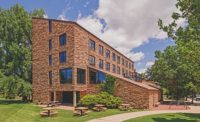CU Boulder Campus Utility Systems Upgrade Tops Out
The campus-wide project to increase the operational efficiency of the University of Colorado’s campus utility systems in Boulder has achieved a major milestone.

More than 150 field workers and representatives from the project team celebrated the topping out on Nov. 11. The team includes JE Dunn Construction, Denver; Lutz, Daily & Brain LLC Consulting Engineers, Overland Park, Kan.; The RMH Group, a mechanical and electrical engineering firm based in Lakewood; and LOA Architecture of Denver. The last piece of structural steel was placed on the new East District Energy Plant portion of the project. The ceremony also celebrated the team’s significant safety achievement of 339 days without a lost-time accident.
The CU project will greatly improve energy efficiency and reduce carbon emissions, which is in line with the campus-wide goal to minimize its environmental footprint and achieve near “net-zero” carbon emissions.
The multi-phased project is anticipated to be fully operational by winter 2014 and has three main elements:
• Construction of a new heating and cooling plant that will be known as the East District Energy Plant (EDEP) and will serve as a showcase for energy-efficient concepts.
• Renovation of the existing 102-year-old Powerhouse, to be renamed the West District Energy Plant, or WDEP
• Interconnection of the two plants with new and upgraded distribution systems. The centerpiece of the carbon-reduction effort for this project involves overhauling existing natural gas-fired cogeneration equipment in the soon-to-be renovated WDEP to produce both steam and electrical power.
Cogeneration produces considerably less carbon dioxide than power generated by the local utility company. The already-efficient cogeneration system will be enhanced to increase electrical power output by as much as 25% without burning any additional fuel by using combustion turbine exhaust to produce steam from heat that would otherwise be wasted.
These strategies, along with several others, will reduce carbon emission by approximately 33,000 tons per year. To help recognize project sustainability efforts, LEED-Gold certification is being pursued for the new EDEP building.
When connected, the two plants will work in tandem to deliver a higher level of efficiency and reliability than would otherwise be achieved from a single plant. Initial chilled-water capacities from the interconnected plants will accommodate new distribution to the Kittredge Housing Complex, enabling the residence halls to be air conditioned for the first time since they were built nearly 50 years ago.

